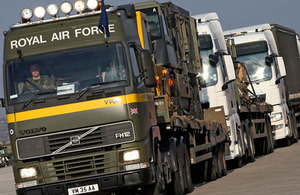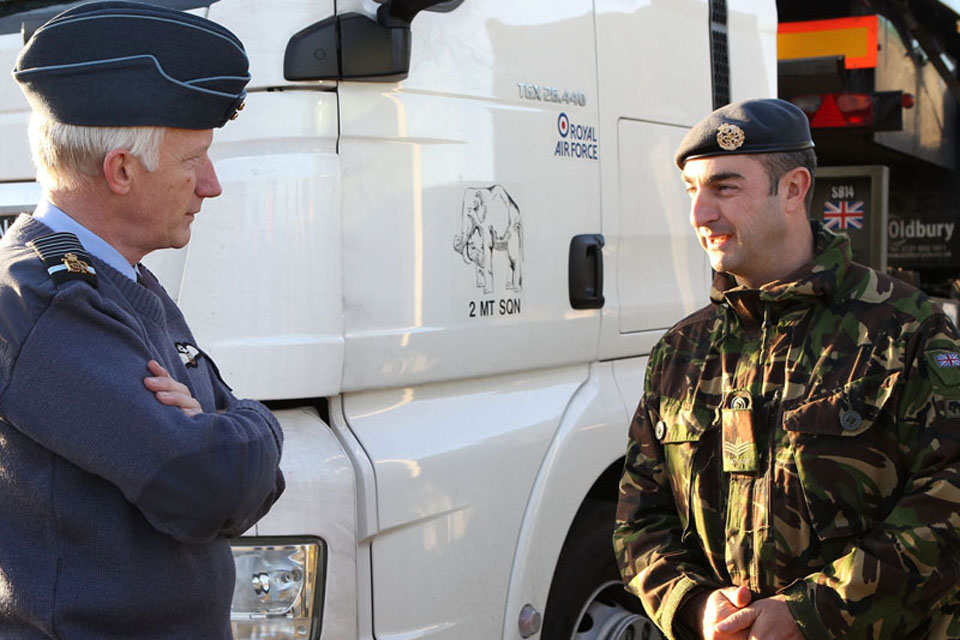Last RAF convoy comes home following Libya operations
The Chief of the Air Staff, Air Chief Marshal Sir Stephen Dalton, has welcomed home the final RAF vehicle convoy from Italy following the end of UK operations over Libya.

2 Mechanical Transport Squadron's 12 vehicle convoy recovered military vehicles, jet parts, and unused supplies from Gioia del Colle [Picture: Senior Aircraftman Adam Fletcher, Crown Copyright/MOD 2011]
Sir Stephen met personnel from No 2 Mechanical Transport Squadron (2 MTS) as they arrived back at their base in RAF Wittering, Cambridgeshire. He chatted with the drivers and got a first-hand account of the challenges they faced.
During the two-hour visit, Sir Stephen took the opportunity to drive an Oshkosh Close Support Tanker (adorned with a 4-star plate), before visiting the 2 MTS Operations Room, No 5001 Squadron’s Station Engineering Flight and No 3 Mobile Catering Squadron.
During Op ELLAMY, the UK operation over Libya, 2 MTS’s vehicles drove 1,169,986 miles (1,882,910km); which is equivalent to travelling around the equator more than 47 times, and carried 8,540 tonnes of freight - the equivalent of 813 Hercules aircraft loads.
2 MTS suffered the only operational fatality of the Operation, with the sad loss of Senior Aircraftman James Smart, who was involved in a Road Traffic Accident as his convoy was transiting through southern Italy.
Addressing personnel, Sir Stephen said:
I think there’s no question that, without the support units here, whether it be 2 MT, the hangar erectors, the people who keep everything going, and those who keep us fed in various parts of the world recently, we would not have been able to be as effective as we have been.

Air Chief Marshal Sir Stephen Dalton, Chief of the Air Staff, talking to Sergeant Wayne Merrix RAF of No 2 Mechanical Transport Squadron [Picture: Senior Aircraftman Adam Fletcher, Crown Copyright/MOD 2011]
For Sergeant Wayne Merrix, this convoy was his last before leaving the RAF. His final trip retraced the steps of his first journey with the Squadron more than a decade ago:
My first encounter with the Squadron was 12 years ago when I travelled down with them to Gioia del Colle, and my last trip with 2 MT was to the same destination,” he said.
The journeys to and from southern Italy ferried cargoes varying from to explosive ordnance to aircraft wheels:
It’s quite a lonely trip, four days there, four days back,” said Sgt Merrix. “It’s a challenge to do 4,000 miles [6,437km] on your own and maintain the level of concentrations you have to apply. We do stop regularly, but on the continent it can be difficult sometimes to find somewhere to park 10 trucks overnight.
Group Captain Richard Hill, Station Commander at RAF Wittering, summarised the performance of his personnel:
Op ELLAMY represented the first time for many years that the RAF has undertaken an expeditionary operation. The role played by units and personnel from the station was crucial in delivering, at pace and over extended lines of communication, many of the logistics and supporting services necessary to enable the operation.
I am extremely proud of the contribution that these personnel have made, and delighted that the Chief of the Air Staff took the time and trouble to visit RAF Wittering and pass on his personal appreciation to a cross-section of the personnel who had been involved.
Op ELLAMY has again highlighted the importance of logistic support and underlined the role of the RAF’s logistics personnel on deployed operations.
We will continue to refine the level and types of support we provide, and continue to develop/enhance the working relationship we have with Headquarters Air Command, and the Expeditionary Air Wings, such that we are able to meet whatever challenges may arise in the future.